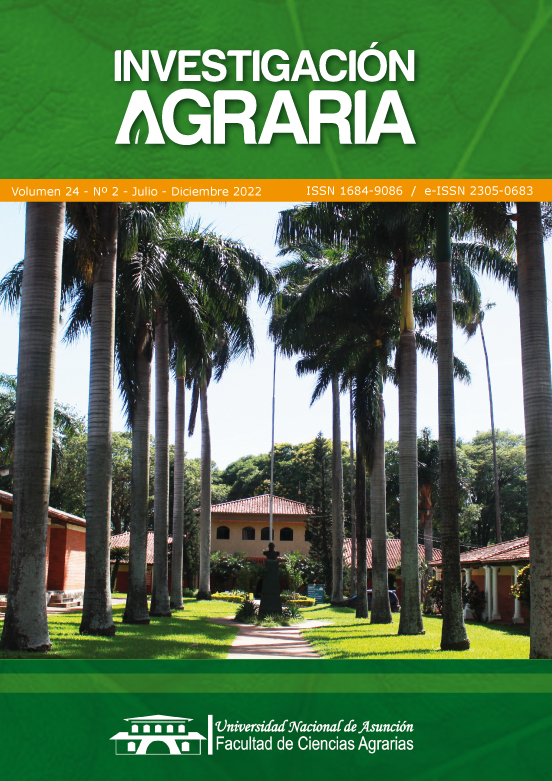Bioecology of Bactericera cockerelli (Sulc.) on potato (Solanum tuberosum L.) crops in provinces of Tungurahua and Cotopaxi, Ecuador
DOI:
https://doi.org/10.18004/investig.agrar.2022.diciembre.2402707Keywords:
potato psillid , biology, geographic distribution, intra-plant distribution, population fluctuationAbstract
The potato psyllid, Bactericera cockerelli (Šulc) (Hemiptera: Psyllidae) has gained more relevance in recent years due to its invasive ability, wide range of host plants and ability to transmit pathogens. Due to it was recently reported in Ecuador, in this study the geographical distribution, intra-plant distribution and biology of B. cockerelli was studied on potato in the provinces of Tungurahua and Cotopaxi. Sampling was carried out in 14 localities from five municipalities of Tungurahua province (Ambato, Tisaleo, Mocha, Quero and Pelileo) and in five localities from Cotopaxi province (Municipality of Salcedo). Biology was studied on potato leaves cultivar Super Chola under laboratory conditions (21.2 ° C and 49.6% relative humidity). The pest was detected in 7 of the 14 localities sampled in the Ambato and Píllaro (Tungurahua), while in the Salcedo (Cotopaxi) it was found in three of the five sampling locations. Regarding the intra-plant distribution, wide variability was observed in the different strata of the plant (upper, middle, and lower), suggesting that the pest does not show preference to select the substrate for oviposition or feeding. The biological cycle showed an average total duration of 22.93 days, with 59.6% mortality rate during the egg phase. The results obtained show important information on the bioecology of B. cockerelli in this region, however, studies are required to evaluate other aspects of the pest.Downloads
Metrics
References
Antolínez, C. A., Moreno, A., Ontiveros, I., Pla, S., Plaza, M., Sanjuan,…, Fereres, A. (2019). Seasonal Abundance of Psyllid Species on Carrots and Potato Crops in Spain. Insects, 10(9), 287. doi:10.3390/insects10090287
Castillo Carrillo, C., Fu, Z. & Burckhardt, D. (2019). First record of the tomato potato Psyllid Bactericera cockerelli from South America. Bulletin of Insectology, 72(1), 85–91.
Crespo-Herrera, L. A., Vera-Graziano, J., Bravo-Mojica, H., López-Collado, J., Reyna-Robles, R., Peña-Lomelí, A., Manuel-Pinto, V. & Garza-García, R. (2012). Distribución espacial de Bactericera cockerelli (Sulc) (Hemiptera: Triozidae) en tomate de cáscara (Physalis ixocarpa (Brot.). Agrociencia, 46(3), 289–298.
Djaman, K., Higgins, C., Begay, S., Koudahe, K., Allen, S., Lombard, K. & Neill, M. O. (2020). Seasonal Occurrence of Potato Psyllid (Bactericera cockerelli) and Risk of Zebra Chip Pathogen (Candidatus Liberibacter solanacearum) in Northwestern New Mexico. Insects, 11(3), 1–13. doi:10.3390/insects11010003
European and Mediterranean Plant Protection Organization. (2013). EPPO Data Sheets on pests recommended for regulation. Fiches informatives sur les organismes recommandes pour reglementation. Bactericera cockerelli, Bulletin OEPP/EPPO, 43(2), 202-208. doi:10.1111/epp.12044
Liefting, L. W., Sutherland, P. W., Ward, L. I., Paice, K. L., Weir, B. S. & Clover, G. R. G. (2009). A new ‘Candidatus Liberibacter’ species associated with diseases of solanaceous crops. Plant Disease, 93, 208–214.
Munyaneza, J. E. & Henne, D. C. (2013). Leafhopper and Psyllid Pests of Potato. In A. Alyokhin, C. Vincent & P. Giordanengo (Eds.), Insect Pests of Potato. Academic Press. doi:10.1016/B978-0-12-386895-4.00004-1
Olaniyan, O., Rodríguez-Gasol, N., Cayla, N., Michaud, E. & Wratten, S. D. (2020). Bactericera cockerelli (Sulc), a potential threat to China’s potato industry. Journal of Integrative Agriculture, 19(2), 338–349. doi:10.1016/S2095-3119(19)62754-1
Organización de las Naciones Unidas para la Alimentación y la Agricultura. (2022). Datos de cultivos. FAOSTAT. http://www.fao.org/faostat/es/#data/QC
Prager, S. M., Butler, C. D. & Trumble, J. T. (2014). A Binomial Sequential Sampling Plan for Bactericera cockerelli (Hemiptera: Triozidae) in Solanum lycopersicum (Solanales: Solanacea). Journal of Economic Entomology, 107(2), 838–845. doi:10.1603/ec13328
Prager, S. M. & Trumble, J. T. (2018). Psyllids: Biology, Ecology, and Management. In W. Wakil, G. E. Brust, & T. M. Perring (Eds.), Sustainable Management of Arthropod Pests of Tomato. Academic Press. doi:10.1016/B978-0-12-802441-6.00007-3
Yang, X.-B. & Liu, T.-X. (2009). Life History and Life Tables of Bactericera cockerelli (Homoptera: Psyllidae) on Eggplant and Bell Pepper . Environmental Entomology, 38(6), 1661–1667. doi:10.1603/022.038.0619
Yang, X.-B., Zhang, Y.-M., Hua, L. & Liu, T.-X. (2010). Life History and Life Tables of Bactericera cockerelli (Hemiptera: Psyllidae) on Potato Under Laboratory and Field Conditions in the Lower Rio Grande Valley of Texas. Journal of Economic Entomology, 103(5), 1729–1734. doi:10.1603/ec10083
Published
How to Cite
Issue
Section
License
Copyright (c) 2023 Maribel Manobanda, Pablo López, Carlos Luis Vásquez Freytez

This work is licensed under a Creative Commons Attribution 4.0 International License.
All content in this journal is under Creative Commons Attribution License.









 All content in this journal is under
All content in this journal is under 